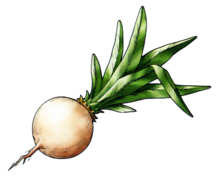Moonwort bulb
Moonwort bulb (formerly Full Moon Herb) is a recurring curative item in the Dragon Quest series. It is used to alleviate the paralysis status effect and, in VII and VIII, slumber.
Appearances
Dragon Quest III
Moonwort bulbs are very vital in their first appearance, as the paralysis status does not remedy itself during battle and if the whole party is stunned it counts as a wipe out.
Dragon Quest IV
The spell Tingle has been modified to affect all party members, diminishing the importance of the plant slightly. However, as only Meena will learn the spell most players keep a few in stock for when she is incapacitated or not in the party.
Dragon Quest V
Several monsters will learn Tingle, further reducing the importance of the plant. However, due to the random nature of taming it is still advised to have a bushel on hand for safety's sake. Furthermore, the accuracy of the enemy version of Burning Breath has risen significantly in the DS and mobile device versions of the game, thus necessitating cultivation for allies who aren't outright immune to being paralyzed.
Dragon Quest VI
Paralysis has been modified to wear off in battle after a number of turns, as with bedazzlement and sleep, making moonwort bulbs entirely unnecessary. Additionally, any character can learn Tingle after reaching rank 4 in the Priest vocation.
Dragon Quest VII
Moonwort bulbs have been cross-pollinated extensively to breed a more useful root, curing sleep as well as paralysis.
Dragon Quest VIII
The Moonwort bulb was yet further refined, now targeting everyone in the party. Additionally, three bulbs can also be mixed to make a Moon's mercy. They are also used to create a Rose-wort and Mystifying mixture.
Dragon Quest IX
The moonwort bulb has lost its anti-narcoleptic properties, but is featured in the same recipes as before (sans mystifying mixture) along with the Panacea.
Notes
The moonwort bulb's original translation "full moon herb" suggests that the plant only flourishes in moonlight, explaining the plant's selenite shape.
